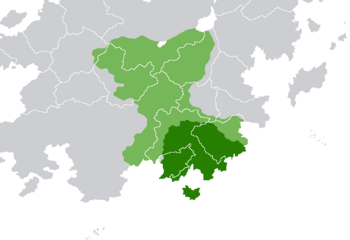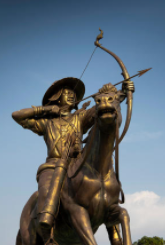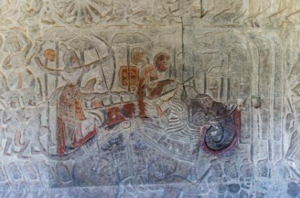Svai Empire
Svai Empire 向國 Svayhkau | |||||||||||||||||||||||
|---|---|---|---|---|---|---|---|---|---|---|---|---|---|---|---|---|---|---|---|---|---|---|---|
| 304 CE–1311 CE | |||||||||||||||||||||||
|
Flag | |||||||||||||||||||||||
 Svai Empire over modern borders. Dark green represents the core empire, light green the empire at its height in 866 CE. | |||||||||||||||||||||||
| Capital | Siran 304-486 Kantala (486-711 and 718-1214) | ||||||||||||||||||||||
| Common languages | Svai Nieh Tchin Nainanese | ||||||||||||||||||||||
| Religion | Zohism | ||||||||||||||||||||||
| Government | Imperial absolute monarchy | ||||||||||||||||||||||
| Emperor | |||||||||||||||||||||||
• 304-316 | Stechaphnom I | ||||||||||||||||||||||
• 705-739 | Prakphan | ||||||||||||||||||||||
| History | |||||||||||||||||||||||
• Established | 304 CE | ||||||||||||||||||||||
• Disestablished | 1311 CE | ||||||||||||||||||||||
| |||||||||||||||||||||||
| Today part of | Siamat Kuthina Nainan | ||||||||||||||||||||||
The Svai Empire (Svai: 向國 Svayhkau, called 暹末 Shangean: Xiānmò by the Sun and Tao dynasties) was an empire in Southeast Coius which lasted from the 4th to 14th centuries. It was created by Stechaphnom I in 304 CE after a successful revolt against the Sun dynasty, which had ruled the area since 155 CE. Until the 7th century CE it was largely confined to the Lueng and Moei river valleys, and afterwards it conquered and subjugated parts of modern-day Nainan, Zomia, and Shangea. It reached its zenith during the 9th century when the Tagamic Migration devastated the Heavenly Dominion in Pardaria and the Tao dynasty in Shangea, allowing the Svai Empire to establish a protectorate over much of the Great Steppe and Chanwa for 70 years.
During this period, known as the Venghuo Period, Svai culture flourished as it incorporated aspects of Shangean, Pardarian, Nainanese, and Dezevauan customs, literature, and philosophy from trade. It is considered a golden age of Svai artists, poets, architects, and writers. Zohism became entrenched in this period, with the system of Sengshui fully adopted to provide governance for the empire. The capital of Kantala grew to host over a million people, being the largest city in the world for a century, and the Svai emperors patronised over a thousand temples in the capital alone.
The 10th century saw the beginning of the end for the Venghuo Period. The Svai Court further retreated from governance, leaving rule in the hands of Zohist monks. With a lack of support from a stagnant and corrupt central military, the monks turned to the Oknya, local gentry, who were allowed to raise militias. Over time the Oknya took power from the monks and cemented themselves as regional warlords, focusing on increasing their power-bases at all costs. During this Peanchao period banditry ran rampant and the empire shrank dramatically. The Oknya encouraged the Kasi Migrations by hiring Kasi as mercenaries and settling them in garrison towns. This policy would prove disastrous as the Kasi would later revolt and establish their own kingdoms, gaining control of much of the Lueng and Moei river valleys.
The Svai Empire would continue on as a rump state until the Sack of Ourieng in 1311 by the Kingdom of Sippom.
History
Rebellion and establishment
By the start of the 4th century Lueng river valley had largely been under the control of the Sun dynasty for two and a half centuries, and had known a short but influential rule earlier by the Xiang dynasty. During the 3rd century the Sun dynasty conquered the city-state of Vanam which dominated the Moei river valley and the Mahakram Gulf, which stretched its resources in the area. As the dynasty began to decline it could afford less attention to its frontiers and far-off provinces, suffering numerous rebellions which saw its hold of the area weakened.

One of these rebellions was led by a figure called Stechaphnom, who would found the Svai Empire and its capital of Kantala. As a highly mythologised figure few authentic historical records remain. The legends paint him as a highly successful general who was able to overcome Sun armies by adapting to their tactics and weaponry and using them against them. He is often considered a pivotal figure in synthesising native Svai culture, beliefs, and political systems with that of the occupying Shangeans, which is credited to the success of his rebellion where others failed.
The date traditionally given for his foundation of the Svai Empire is 304, although there are no contemporary records or steles that support this. Sun dynasty records indicate only that appointments to the commanderies in the area did not stop, suggesting some kind of continued presence in the area. Archaeological evidence has supported this, indicating that Stechaphnom and his early successor ruled only part of the Middle Lueng, and fought against other states formed in the absence of Sun authority in the Lower Lueng and the Moei river valleys. Historians now believe later Svai histories would revise history and suggest a far more dramatic collapse of Sun control in the region, while they now believe in a slower decline allowing native polities to remerge, one of which, founded by Stechaphnom and centred in Kantala (originally Siran), would become the Svai Empire.
Early empire
Venghuo period
Rapid expansion
Decline
Peanchao period
End of the empire
Administration and politics
Legal code
Government
Imperial examinations
Sengshui
Local governance
Taxes and the census
Military and foreign policy
Protectorates and tributaries
In emulation of the Xiang dynasty, and succeeding Shangean dynasties, the Svai Empire considered itself the centre of the world and all other states, bar the Tao dynasty, to owe it fealty or tribute. Like the Sun dynasty which it had broken off from it was aggressive in establishing tributary relations. In the 6th century it conquered the Yên dynasty and forced the Ban dynasty to become a subject state. Initially it saw tributaries as active vassal states, and often intervened in their internal politics and levied taxes both on goods and manpower. This created numerous problems that saw multiple revolts from the Ban, and so this model was not replicated elsewhere.
At its zenith in the 9th century the Svai Empire expanded its list of tributaries tenfold, grouping many of them into three protectorates: the Bakan Protectorate in the Great Steppe, the Saian Protectorate to the west, and the Sanan Protectorate in the north-east. The Sanan Protectorate was the least organised, theoretically it stretched as far as modern-day Lavana but in reality few states sent consistent tribute missions, with most deigning to send them every decade or so when they desired to establish trade relations.
By the 10th century the Protectorates as organised groups of tributaries and vassals had largely fallen apart. Without adequate support from the central army the viceroys were forced to concede all but a few territories, and in turn those too were soon lost. After the 11th century few states saw any need to send tribute to Kantala, having returned fully to the Tao's fold. Those that did were largely small Lue polities in the north, seeking legitimacy from the Svai Emperor and to keep trade flowing through the mountain passes.
Bakan Protectorate

The Tagamic Migrations caused an upheaval in the Great Steppe and resulted in the weakening of the Heavenly Dominion and the Tao dynasty. The former had to deal with the devastation caused by the Tagames, while the latter was beset by Omiric tribes migrating into its frontiers. The reigning emperor in 831, Ponhea Yat, was asked by nearby Chanwan polities to secure the border. Over a three year campaign his general, Sar Kosal, subjugated fourteen Omiric and Ukilenic tribes.
For the next 72 years a good deal of the Great Steppe was organised under the Bakan Protectorate, officially the 'Grand Protectorate General to Pacify the North'. It had its capital at Tulean, although most protector-generals served from the garrison city of Tboudong. Due to its vast size, distance from Kantala, and a lack of adequate resources provided to the protector-generals, Svai oversight of the area was lax and largely amounted to collecting tribute, protecting the Svai core lands via the Chanxi Corridor, and playing the tribes against each other.
By the late 9th century much of the protectorate had slipped from the empire's grasp, and as the Heavenly Dominion and Tao dynasty recovered the imperial court did not want to challenge them and so retreated from the area. The protector-general was reduced to holding Tboudong and protecting the Chanxi Corridor, and later when that was lost was diminished to a ceremonial court rank before the institution was forgotten after the fall of the empire in 1311.
Central army
Relations with Shangea
Economy
Silk and gold roads
Maritime trade
Culture and society
Art
Kantala, the capital
Religion and philosophy
Court and leisure
Sumptuary laws and clothing
Position of women
Cuisine
Science and technology
Engineering
Architecture
Agriculture
Historiography
List of rulers
| Reign | Emperor | Capital | Information and events |
|---|---|---|---|
| 304-316 | Stechaphnom I | Siran | Proclaimed the independence of the Svai Empire from the Sun dynasty. |
| 316-333 | Phansopat | Siran | |
| 333-341 | Stechaphnom II | Siran | |
| 341-376 | Sokkiri I | Siran | |
| 376-379 | Sokkiri II | Siran | |
| 379-401 | Suyphala | Siran | |
| 401-414 | Thomkhl I | Siran | |
| 414-443 | Suyphala II | Siran | |
| 443-465 | Suyphala III | Siran | |
| 465-473 | Stechatonle | Siran | |
| 473-478 | Thomkla II | Siran | |
| 478-509 | Stechaphnom III | Siran Kantala |
|
| 509-521 | Preahrith I | Kantala | |
| 521-554 | Sokhdom I | Kantala | |
| 554-556 | Sechaktei I | Kantala | |
| 556-581 | Karnenam | Kantala | |
| 581-598 | Stechbrisot | Kantala | |
| 598-623 | Merosmei I | Kantala | |
| 623-634 | Sokhdom II | Kantala | |
| 634-662 | Thomkla III | Kantala | |
| 662-681 | Davseril | Kantala | |
| 681-684 | Stechomnue | Kantala | |
| 684-684 | Mak Makara | Kantala | |
| 684-705 | Chekhueng | Kantala | 晶王 |
| 705-739 | Prakphan | Kantala Moumar |
Attempted to move the capital to Moumar, returned to Kantala after just seven years. |
| 739-754 | Huothi | Kantala | 和帝 |
| 754-761 | Huthi | Kantala | 谐帝 |
| 761-784 | Mikthi | Kantala | 睦帝 |
| 784-794 | Hsaengthi | Kantala | 盛帝 |
| 794-821 | Chehueng | Kantala | 耀王 |
| 821-845 | Saimchhi I | Kantala | 心主 |
| 845-897 | Huengchhin | Kantala | 王真 |
| 897-912 | Lenhueng | Kantala | 憐王 |
| 912-923 | Khehueng | Kantala | 握王 |
| 923-941 | Kheangchhi I | Kantala | 抗主 |
| 941-966 | Kheangchhi II | Kantala | 抗主 |
| 966-989 | Kheangchhi III | Kantala | 抗主 |
| 989-995 | Saibchhi | Kantala | 接主 |
| 995-1011 | Khuohsaei | Kantala | 恢秩 - Attempted to restore order to a crumbling empire, short reign cut any chance of success |
| 1011-1034 | Kantala | ||
| 1034-1055 | Kantala | ||
| 1055-1063 | Kantala | ||
| 1063-1088 | Kantala | ||
| 1088-1102 | Kantala | ||
| 1102-1137 | Kantala | ||
| 1137-1139 | Kantala | ||
| 1139-1142 | Kasi Naranat occupation, led by King Mahidol | ||
| 1142-1146 | Kantala | ||
| 1146-1164 | Kantala | ||
| 1164-1175 | Kantala | ||
| 1175-1199 | Kantala | ||
| 1119-1214 | Kantala | ||
| 1214 | Kasi Sippom invasion, culminating in the Sack of Kantala | ||
| 1214-1226 | Ourieng | ||
| 1226-1231 | Ourieng | ||
| 1231-1255 | Ourieng | ||
| 1255-1258 | Ourieng | ||
| 1258-1279 | Ourieng | ||
| 1279-1292 | Ourieng | ||
| 1292-1304 | Ourieng | ||
| 1304-1305 | Ourieng | ||
| 1305-1311 | Ourieng | ||


